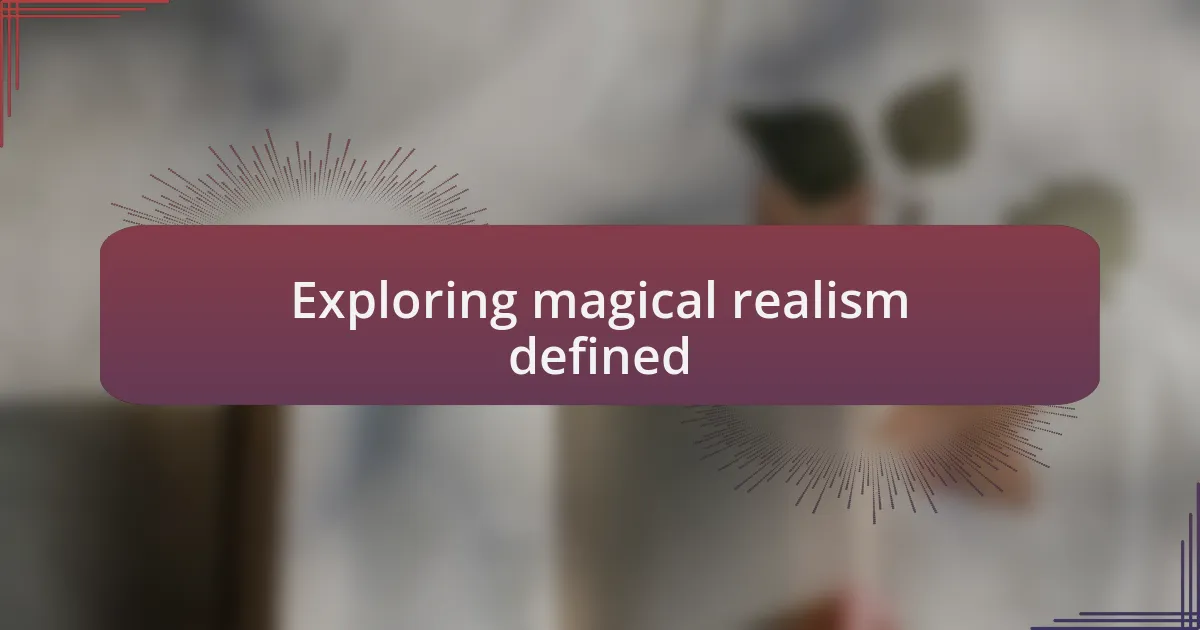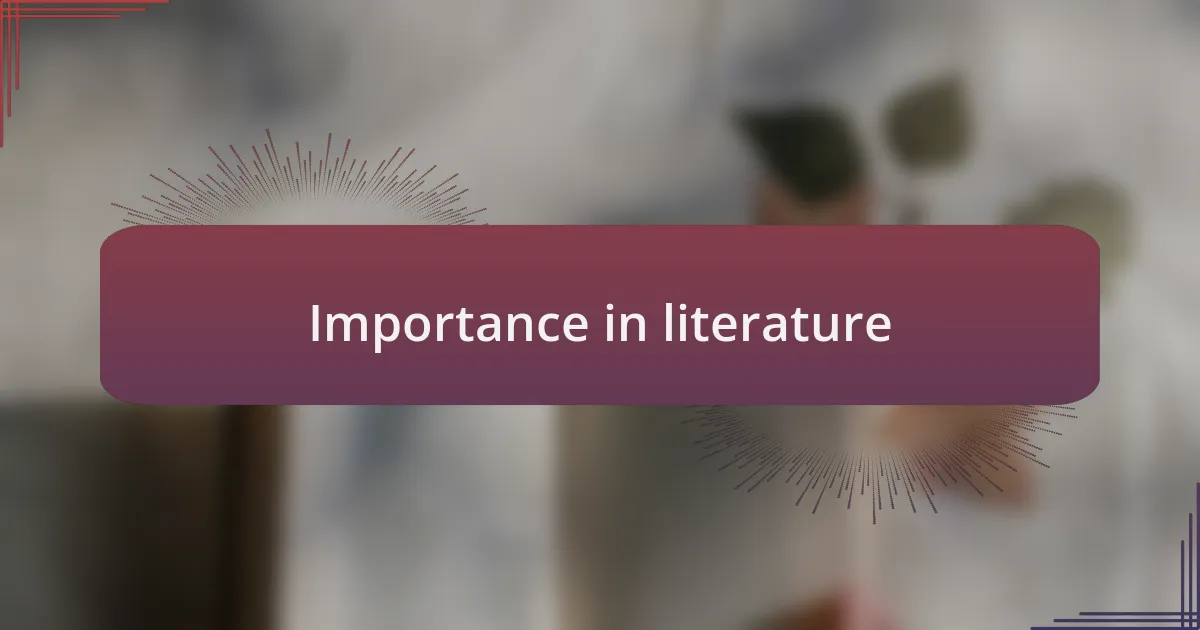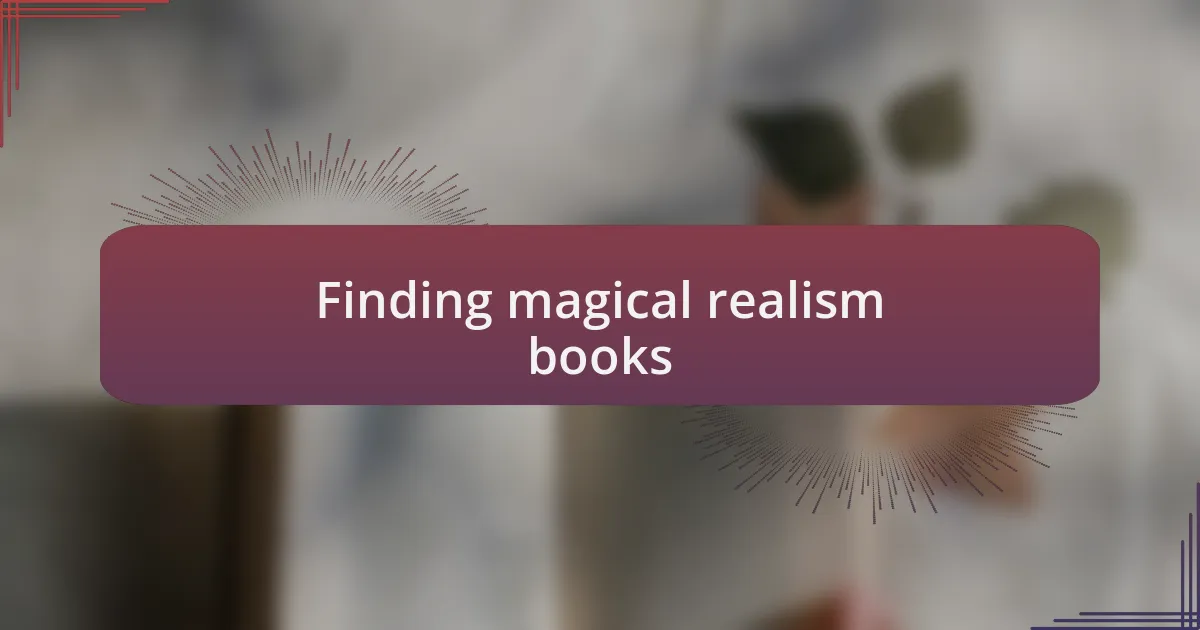Key takeaways:
- Magical realism intertwines the ordinary and extraordinary, challenging perceptions of reality and enhancing emotional truths.
- Characteristics include treating magical elements as commonplace and exploring cultural issues through a fantastical lens.
- This genre fosters wonder, allowing readers to confront complex emotions and navigate diverse cultural narratives through imaginative storytelling.
- Recommended titles include “The House of the Spirits,” “Love in the Time of Cholera,” and “The Night Circus,” highlighting the genre’s captivating nature.

Exploring magical realism defined
Magical realism is an intriguing genre that seamlessly blends the ordinary with the extraordinary. I remember reading Gabriel Garcia Marquez’s “One Hundred Years of Solitude” for the first time, where the mundane life of Macondo is sprinkled with surreal events, making me wonder—what if the impossible was just a part of everyday life? This genre invites readers to embrace the unbelievable as if it were the norm, creating a unique lens through which we can view the world.
At its core, magical realism challenges our perceptions of reality and fantasy. I often think about how it allows space for deeper emotional truths, illustrating that our feelings can have fantastical qualities. When I encountered stories like “The House of the Spirits” by Isabel Allende, I felt as though I was walking through history intertwined with the supernatural, prompting me to ask myself: how do our cultural narratives shape our understanding of reality?
Through magical realism, the boundaries of what we deem possible are blurred, forcing us to confront our own experiences and beliefs. This genre reflects a more nuanced understanding of life, where magic doesn’t just exist in books; it permeates our everyday moments. I find myself recalling a rainy afternoon, when a simple downpour transformed my surroundings into a dreamlike state—was that reality, or was it a touch of magic?

Characteristics of magical realism
The heart of magical realism lies in its seamless blend of the fantastical with the mundane. I remember one evening in a bustling café where a barista served coffee with an unusual twist—a hint of lavender that seemed to transform my mood instantly. It struck me how such an ordinary moment could feel so extraordinary, capturing the essence of how magical realism elevates everyday experiences into something almost otherworldly.
One defining characteristic is the presence of magical elements treated as commonplace. I once read a story about a family whose matriarch could communicate with the spirits of their ancestors. To me, it was a poignant reminder of how our past shapes our present—almost as if the lessons and stories of those who came before us linger in the air, guiding our choices. Isn’t it fascinating how this genre allows our imaginations to explore these connections in a tangible way?
Another key aspect is the exploration of cultural and social issues through a magical lens. I recall attending a cultural festival where people shared tales that mixed folklore, family history, and whimsical elements. These stories not only entertained but also revealed deeper truths about identity and struggle. Isn’t it powerful how magic can serve as a vehicle for discussing complex realities? This blend invites readers to reflect on their realities, evoking a sense of wonder and introspection.

Importance in literature
The importance of magical realism in literature can’t be overstated; it provides a unique platform for authors to depict complex human emotions in ways that feel both engaging and relatable. I remember reading a novel where the protagonist’s sorrow transformed into a tangible fog, enveloping everything around them. That vivid imagery made me reflect on how grief can often feel inescapable, turning abstract emotions into something we can visualize and understand. Isn’t it remarkable how this genre invites us to confront these feelings in innovative ways?
Moreover, magical realism allows readers to navigate cultural narratives that might otherwise remain hidden. I once encountered a collection of short stories that woven magical elements with the cultural fabric of a community I had never experienced firsthand. It was enlightening; through these fantastical threads, I gained insights into traditions, struggles, and aspirations of people whose lives were remarkably different from mine. Could a dash of magic help bridge the gaps in understanding between diverse cultures?
Finally, the genre fosters a sense of wonder, encouraging readers to question their perceptions of reality. When I read about a world where time flows backward for some characters, it prompted me to ponder the fluidity of our own experiences. Don’t we often find ourselves stuck in time, reminiscing about moments that seem both distant and present? Magical realism sparks these contemplations, enriching the literary experience by blurring the lines between our mundane lives and the extraordinary possibilities that may lie just beneath the surface.

Finding magical realism books
Finding magical realism books can be an enchanting adventure. I vividly remember hunting for a particular gem in this genre and stumbling upon a charming little bookstore tucked away in a quiet corner of my town. The thrill of flipping through the shelves, discovering titles like “One Hundred Years of Solitude,” felt akin to unearthing hidden treasures. Isn’t there something almost magical about the serendipity involved in finding the perfect book that resonates with your own experiences?
Online platforms can also be a fantastic resource for discovering magical realism. I often explore curated lists or recommendations on literary blogs, which have been pivotal in leading me to authors I had never heard of before. There’s an undeniable joy in reading reviews where other enthusiasts articulate what made these stories resonate with them. Have you ever found a book simply because someone else shared their excitement for it?
Visiting local libraries can yield surprising finds as well. I recall seeking out recommendations from librarians who genuinely understood my fondness for stories filled with lyrical prose and whimsical elements. Their insights not only broadened my reading list but also enhanced my appreciation of how magical realism can transform unique narratives into remarkable experiences. How often do we overlook the wealth of knowledge right in our communities?

Recommendations for top titles
When it comes to recommending top titles in magical realism, I can’t help but mention “The House of the Spirits” by Isabel Allende. This novel combines the personal and political in a way that unfolds like a dream. I still remember the first time I read it; the characters felt so vivid, almost as if they were inviting me into their ancestral home. Have you ever lost track of time while engrossed in a book that captivates your heart and mind?
Another standout is Gabriel Garcia Márquez’s “Love in the Time of Cholera.” The way he intertwines love and longing with the extraordinary left me breathless. I recall being enthralled by the rich imagery and the profound exploration of relationships across decades. It’s a perfect testament to how magical realism can tackle the complexities of life with an enchanting touch. What’s your favorite discovery in a novel that surprised you in this genre?
Lastly, I wholeheartedly recommend “The Night Circus” by Erin Morgenstern. The magical elements woven into the circus atmosphere are mesmerizing. I remember my senses being heightened with every page, as the vivid descriptions made the fantastical feel real. As you journey through this tale, have you ever felt as if you were part of the magic, rather than just a reader?